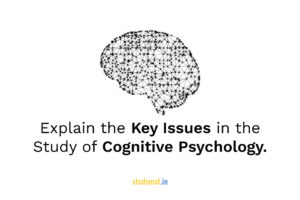In this article, we will Describe the Ink Blot Techniques.
Ink Blot Test :
The Ink Blot techniques consist of two popular techniques, The Rorschach Inkblot Test and The Holtzman Inkblot test. In these tests, the examinee has to respond to an unstructured situation collected of some inkblots.
1. The Rorschach Inkblot Test
The Rorschach inkblot test was developed by Swiss psychiatrist Hermann Rorschach in 1921. It consists of 10 inkblots, 5 in black ink on a white background and 5 in coloured inks on a white background. The Rorschach test is a measure of both intellectual and non-intellectual personality traits. Rorschach experimented with a large number of inkblots which were administered to different psychiatric groups in developing this technique. Based on such clinical observations various psychiatric syndromes that distinguish response characteristics were taken up in the scoring system.
Read Also:
Discuss Various Issues in the Study of Personality.
In the test, the subjects are asked to simply state whatever each inkblot looks like to them. Using predetermined categories the psychologists score responses on key factors such as shape and colour, movement, whether the whole or part blot has been seen, whether the response is given in content to the whole or peculiar details in the blot.
These blots are frequently used for personality description, diagnosis of mental disorders and behaviour predictions (Watkins, Wiener). The whole procedure of The Rorschach Test is a combined set of three components, that is, performance proper, inquiry, and scoring.
2. The Holtzman Inkblot Test
Holtzman developed an inkblot test in 1961 which is known as the Holtzman Inkblot Test (HIT). This test removes the inherent technical difficulties of the Rorschach like the unlimited number of responses, poor scorer reliability etc. There are two parallel forms (A and B) having 45 cards, both coloured and achromatic and significantly asymmetric. One response per card is taken by the respondent. Each response is followed by a two-fold simple question: where was the percept represented in the blot and what the percept suggests about the blot? Then all the responses are classified under 22 response variables.
Read Also:
Define Behavioural Assessment. Discuss the Common Characteristics and Assumptions of Behavioural Assessment.
Many researchers have found that the Holtzman test appears to be better standardised than the Rorschach test. Also, the scorer reliability of the HIT is highly satisfactory validity data on HIT. It has yielded satisfactory results, also overcome the problem of productivity ratio by specifying the number of responses.
Recently, Holtzman has also developed a variant of HIT called HIT 25 in 1988. Consisting of 25 cards it is successful in diagnosing schizophrenia.
Follow us:
If you like this article, you can Follow us on Facebook.
Also, you can Join our Official Facebook Group for QnA Sessions and Discussions with the worldwide IGNOU community.

